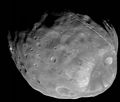Immaggine:Phobos colour 2008.jpg

Dimenscioìn de st'anteprìmma chi: 636 × 600 pixel. Âtre resoluçioìn: 255 × 240 pixel | 509 × 480 pixel | 815 × 768 pixel | 1 086 × 1 024 pixel | 2 172 × 2 048 pixel | 3 500 × 3 300 pixel.
File òriginâle (3 500 × 3 300 pixel, dimensción do file: 2,72 MB, tîpo MIME: image/jpeg)
Cronologîa do file
Sciàcca in sce 'n grùppo dæta/ôa pe védde comm'o l'êa o file into moménto indicòu.
| Dæta/Ôa | Miniatûa | Dimenscioìn | Uténte | Coménti | |
|---|---|---|---|---|---|
| prezénte | 05:10, 2 arv 2018 |  | 3 500 × 3 300 (2,72 MB) | Kaldari | more margin on right side |
| 06:47, 13 nov 2008 |  | 3 374 × 3 300 (2,7 MB) | Fir0002 | == Summary == {{Information |Description=Colour image of Phobos, imaged by the Mars Reconnaisance Orbiter in 2008 |Source=NASA |Date=9 April 2008 |Location=http://www.nasa.gov/mission_pages/MRO/multimedia/pia10368.html |Author=NASA/J |
Utilìzzo do file
A pàgina chi de sótta a contêgne di ligàmmi a sto file chi:
Utilìzzo globâle do file
Quésto file o l'é dêuviou da 'ste âtre wiki ascì:
- Dêuviòu inte pàgine de af.wikipedia.org chi de sótta:
- Dêuviòu inte pàgine de an.wikipedia.org chi de sótta:
- Dêuviòu inte pàgine de ar.wikipedia.org chi de sótta:
- المريخ
- فوبوس
- قمرا المريخ
- ويكيبيديا:صور مختارة/الفضاء والكون/نظرة إلى الأعلى
- قائمة أجرام المجموعة الشمسية مرتبة حسب الحجم
- بوابة:علم الفلك/صورة مختارة
- بوابة:المريخ/مقالة مختارة/أرشيف
- بوابة:المريخ/مقالة مختارة/2
- قائمة الأقمار الطبيعية
- خط زمني لاكتشاف كواكب المجموعة الشمسية وأقمارها
- ويكيبيديا:ترشيحات الصور المختارة/القمر فوبوس
- ويكيبيديا:صورة اليوم المختارة/أغسطس 2019
- قالب:صورة اليوم المختارة/2019-08-03
- بوابة:علم الفلك/صورة مختارة/73
- معسكر قاعدة المريخ
- ويكيبيديا:صورة اليوم المختارة/يناير 2022
- قالب:صورة اليوم المختارة/2022-01-04
- Dêuviòu inte pàgine de ary.wikipedia.org chi de sótta:
- Dêuviòu inte pàgine de arz.wikipedia.org chi de sótta:
- Dêuviòu inte pàgine de as.wikipedia.org chi de sótta:
- Dêuviòu inte pàgine de azb.wikipedia.org chi de sótta:
- Dêuviòu inte pàgine de az.wikipedia.org chi de sótta:
- Dêuviòu inte pàgine de be-tarask.wikipedia.org chi de sótta:
- Dêuviòu inte pàgine de be.wikipedia.org chi de sótta:
- Dêuviòu inte pàgine de bg.wikipedia.org chi de sótta:
- Dêuviòu inte pàgine de bh.wikipedia.org chi de sótta:
- Dêuviòu inte pàgine de bn.wikipedia.org chi de sótta:
- Dêuviòu inte pàgine de bn.wikibooks.org chi de sótta:
- Dêuviòu inte pàgine de bs.wikipedia.org chi de sótta:
Véddi l'ûzo globâle de quésto file.




